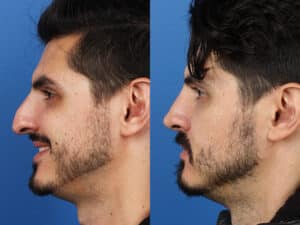Nasal exercises after rhinoplasty
Dr. Philip Miller demonstrates how to keep the nasal bones narrowed after rhinoplasty and to facilitiate the reduction of swelling. Watch the video to learn how you can perform these nasal exercises after your nose job surgery.
NYC expert facial surgeon and rhinoplasty specialist, Dr. Philip Miller explains how to alleviate bruising and swelling after a rhinoplasty procedure through nasal exercises. This video shows how to keep the nasal bones narrowed after rhinoplasty and to facilitate the reduction of swelling.
Nasal exercises, which are oftentimes referred to ‘digital’ exercises, are used as part of postoperative instruction towards the recovery process. Nasal exercises typically involve a massaging motion applied to the nasal bones after rhinoplasty or revision rhinoplasty surgery. During the reshaping processes, the coordinate points of the break in the nasal bone benefit best from this technique in order to ensure optimal desired results and satisfied patients after treatment. It is not only a common practice to be performed, but requires the guidance of a top-qualified professional to help guide repositioning and sustain proper care of the nose. Nasal exercises in its simplest term, assist in correcting and/or completing execution to narrow a wide nose during cosmetic rhinoplasty. Nasal exercises are done to help further contour the nose during the rhinoplasty recovery process.
After reconstruction of an individual’s nasal bones, a nasal cast is applied to the area in order to restrict movement and realignment from the new positon. One’s nasal bones have a natural urge to drift back and shift to original placement if not tended to accordingly. Up to 6-8 weeks post-method is a sensitive time for nasal bones to fuse and fully heal from surgery and comfortably adjust to new position.
Nasal Exercise Technique

Nasal exercises, as noted above, imply placement of pressure by pushing on the bone to put it back into the desired position. As instructed by Dr. Miller, it is typically preferred to use the thumb since it provides a larger ‘pad’ to apply pressure directly against the bone. As indicated, only press on the nasal bone inward toward the middle of the nose, which is approximately the upper one-third of the nasal bridge. Avoid pushing on the top section of the bridge. For achieving optimal outcome, maintaining proper position of the thumb print below the plane of the bridge is vital.
It is ideal for patient to push down hard enough to experience a soft degree of pain- like how one pushes through soreness when working out. And just like the “no pain, no gain” mantra, if you not feel that tenderness you are likely not effecting any real change or sustainability. A patient is advised to hold down this position steady somewhere between 10 extended seconds to approximately one minute. This should be executed repeated between 25-40 times throughout the day depending in conjuction with specific recommendations from your rhinoplasty surgeon. A patient’s trained specialist will suggest if there needs to be an equivalent adjacency or if bilateral exercises (push harder on the left versus right or vice versa) are what is necessary. Desired symmetry and stability of the nose is key to the focal point of the face.
Benefits Of Nasal Exercises
The huge benefit of doing nasal exercises following rhinoplasty or revision rhinoplasty is that it can truly optimize the surgical results and achieve the best possible surgical aesthetic.
Nasal reshaping is a collaborative effort between the facial plastic surgeon and patient. There are many variables to be accounted for following any invasive procedure.
Timing and technique will maximize a patient’s overall satisfaction of their surgical experience and their results!
Additional Resources:
Septoplasty Turbinate Reduction Surgery, Nose Cosmetic Surgery, Nose Fracture Surgery, Different Types Of Noses, Care Credit Rhinoplasty